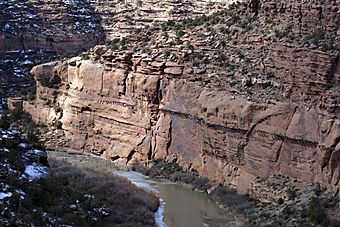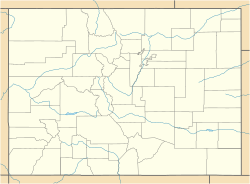Hanging Flume facts for kids
Quick facts for kids |
|
|
Hanging Flume
|
|

Remnants of the Hanging Flume
|
|
| Location | 5.7 mi. NW of Uravan on CO 141, Uravan, Colorado |
|---|---|
| Area | 4.4 acres (1.8 ha) |
| Built | 1889 |
| NRHP reference No. | 80000917 |
| Added to NRHP | May 15, 1980 |
The Hanging Flume was a special kind of open water channel built high up on the side of the Dolores River Canyon in Colorado. It was like a long, wooden waterslide for water! The Montrose Placer Mining Company built it in the 1880s to help them find gold. Today, some parts of the flume are still stuck to the canyon wall, even though most of the wood has disappeared.
Contents
Why Was the Hanging Flume Built?
The Montrose Placer Mining Company wanted to find gold. They planned to get gold from "placer deposits" along the Dolores River. Placer deposits are places where gold bits have settled in sand or gravel, often in riverbeds.
A popular way to get this gold was called Hydraulic mining. This method used powerful jets of water to wash away dirt and gravel, leaving the heavier gold behind. To do this, miners needed a lot of water with strong pressure. Wooden flumes were perfect for moving water efficiently.
Flumes built on cliffs were first used in California. They used wooden supports called trestles and bents to hold the flume box up. The Hanging Flume was connected to a six-mile-long ditch. Both were made to bring water to miners in the San Juan Mountains of Colorado.
How Was the Hanging Flume Built?
Building the Hanging Flume took three years, starting in 1887. About 24 workers helped build it. They hung from ropes on the side of the steep cliff! A special crane, called a derrick, might have been used too.
The project used a huge amount of wood: 1.8 million board feet of lumber. The total cost was over $100,000, which was a lot of money back then! Most of the wood came from local Ponderosa pine trees. Iron rods helped hold the wood in place.
When it was finished, the flume was about 12 miles (19 km) long. It was up to 75 feet (23 m) above the river in some spots. The flume started at a dam on the San Miguel River near Uravan, Colorado. The starting point, called the headgate, is gone now. The ditch that connected to it has also been filled in.
The wooden flume itself was 6 feet (1.8 m) wide and 4 feet (1.2 m) deep. When it was working, it carried an amazing 80,000,000 gallons of water every single day!
Why Was the Flume Abandoned?
Sadly, the Hanging Flume was only used for three years. The mine it was built for closed down. Miners discovered that most of the gold they hoped to find could not be easily recovered. The people who invested in the project lost a lot of money. They put in over $1,000,000 for the mine and the flume, but only made $80,000 back. After the mine closed, local people took the wood from the flume to use for other things.
What's Left of the Hanging Flume Today?
The Hanging Flume is in poor condition now. Some parts have been damaged on purpose, and much of its wood is gone. What wood is left has worn away, especially where it's exposed to the weather. The pine wood is easily damaged by decay and fungi.
In April 2004, engineers who study structures went down to the flume. They used ropes to reach seven different spots. They measured and checked the flume's design, especially the wooden supports called bents. They found five different types of these supports. This study is helping experts think about how they might rebuild parts of the flume using the pieces that are still there.
Images for kids






